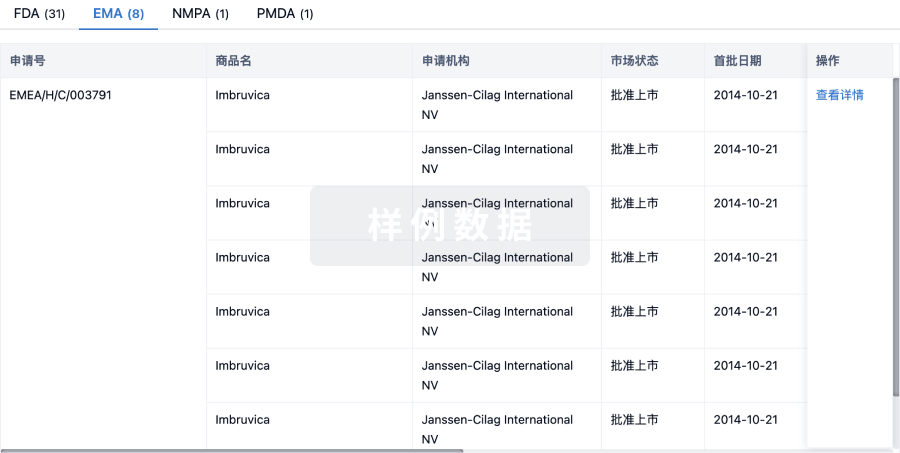预约演示
更新于:2025-11-01
GAT-211
更新于:2025-11-01
概要
基本信息
权益机构- |
最高研发阶段临床前 |
首次获批日期- |
最高研发阶段(中国)- |
特殊审评- |
结构/序列
分子式C22H18N2O2 |
InChIKeyOHZDCJJHWPHZJD-UHFFFAOYSA-N |
CAS号102704-40-5 |
关联
100 项与 GAT-211 相关的临床结果
登录后查看更多信息
100 项与 GAT-211 相关的转化医学
登录后查看更多信息
100 项与 GAT-211 相关的专利(医药)
登录后查看更多信息
55
项与 GAT-211 相关的文献(医药)2025-10-15·ACS bio & med chem Au
Allosteric Modulation of Cannabinoid Type 1 Receptor by ZCZ011: Integration of In Vitro Pharmacology and Molecular Dynamics Simulation
Article
作者: Lichtman, Aron H. ; Yadav-Samudrala, Barkha J. ; Fitting, Sylvia ; Ignatowska-Jankowska, Bogna M. ; Chirasani, Venkat R. ; Yadav, Tara Chand ; Wu, Zhixing ; Swaminathan, Lakshmipriya Indira ; Lu, Dai
Over the years, the cannabinoid type 1 receptor (CB1R) has emerged as a promising therapeutic target for addressing various neurodegenerative diseases including HIV-associated neurocognitive disorders (HAND). However, the therapeutic application of direct CB1R activation is often hindered by undesirable psychoactive side effects. To mitigate this issue, research has focused on utilizing positive allosteric modulators (PAMs) to enhance the CB1R activity indirectly. Preclinical studies have highlighted the efficacy of CB1R PAMs, such as ZCZ011 and GAT211, in mouse models of Huntington's disease, neuropathic pain, and, more recently, HAND. Building on this evidence, we employed primary frontal cortex neuronal cultures and whole brain microglial cultures to investigate the direct and indirect effects of racemic ZCZ011 against the HIV-1 trans-activator of transcription (Tat)-induced excitotoxicity. In parallel, molecular modeling and molecular dynamics simulations were conducted using the ZCZ011 enantiomers (R)-ZCZ011 and (S)-ZCZ011, to elucidate their binding profiles at CB1R. Our in vitro studies revealed that ZCZ011 demonstrated neuroprotective effects against Tat-induced excitotoxicity in the presence of N-arachidonoylethanolamine (AEA) in a dose-dependent manner. Interestingly, racemic ZCZ011 exhibited neuroprotective properties even in the absence of AEA, deviating from the classical behavior of a true PAM. This prompted further investigation into the binding profiles of the enantiomers. Molecular modeling revealed that (R)-ZCZ011 and (S)-ZCZ011 bind to distinct sites on CB1R, aligning with the binding profiles of other CB1R allosteric modulators, GAT228 and GAT229. Notably, (R)-ZCZ011 exhibited a higher number of hydrogen bonds and both polar and nonpolar interactions with CB1R, enhancing the stabilization of AEA binding to CB1R. In summary, these findings suggest that (R)-ZCZ011 may function as both a PAM and an allosteric agonist, like GAT228, while (S)-ZCZ011 may act as a pure PAM, resembling GAT229. This dual functionality underscores the therapeutic potential of ZCZ011 in modulating CB1R activity for a number of neuroprotective applications.
2025-05-01·Small
Custom‐Designed Robust MOF‐Catalyst for Scalable 1,4‐DHP Drugs With H–Bonding‐Mediated Tandem Hantzsch Condensation and Shape‐Reliant Friedel‐Crafts Alkylation
Article
作者: Neem, Mahesh ; Chand, Rudra ; Palakkal, Athulya S. ; Neogi, Subhadip
Abstract:
Flanked –NH2 functionality, polar carbonyl moiety and intrinsically unsaturated [Zn2(CO2)2(ATz)4] center‐decked micropores in an ultra‐robust metal‐organic framework (MOF) are reported, assembled from bent dicarboxylate and triazole (ATz) ligand. The MOF serves as one‐of‐a‐kind tandem Hantzsch condensation catalyst to yield a multitude of 1,4‐dihydropyridines (1,4‐DHPs) with low catalyst loading, short reaction duration at moderate temperature. Importantly, the MOF is used in the synthesis of six 1,4‐DHP‐based therapeutic molecules in >95% conversion, which are characterized in purest form via X‐ray crystallography besides other spectroscopic analyses. Apart from gram‐scale production of ethidine molecule at 40 °C in just 30 min, oxodipine drug is first‐time synthesized by any framework‐based catalyst. This mixed‐ligand MOF further demonstrates highly recyclable Friedel–Crafts (FC) alkylation of indole and β‐nitrostyrene and covers twenty electronically diverse substrates under relatively green conditions. Strikingly, larger‐sized substrates can't diffuse inside the micropores and exemplifies rarest shape‐reliant C‒C coupling reaction. Contrary to conventional Lewis‐acid activation, the maximum contribution from hydrogen‐bonding site promotes both tandem multi‐component and FC reactions, as comprehensively supported from control experiments, analyte‐induced emission articulation, inferior activity of task‐specific site‐truncated isoskeletal MOF, and density functional theory results. This work provides a major advancement on unconventional heterogeneous catalysis to produce valuable products.
2025-01-23·JOURNAL OF MEDICINAL CHEMISTRY
Novel Orthosteric/Allosteric Ligands of Cannabinoid Receptors: An Unexpected Pharmacological Profile
Article
作者: Ortore, Gabriella ; Della Vedova, Larissa ; Giammattei, Gaia ; Chiellini, Grazia ; Banti, Matteo ; Gado, Francesca ; Migone, Chiara ; Ferrisi, Rebecca ; Rapposelli, Simona ; Piras, Anna Maria ; Laprairie, Robert B. ; Manera, Clementina ; Baron, Giovanna ; Polini, Beatrice ; Smolyakova, Anna Maria
The design of dualsteric/bitopic receptor ligands as compounds capable of simultaneously interacting with both the orthosteric and an allosteric binding site has gained importance to achieve enhanced receptor specificity and minimize off-target effects. In this work, we reported the synthesis and biological evaluation of a new series of compounds, namely, the RF series, obtained by chemically combining the CB1R ago-positive allosteric modulators (PAM) GAT211 with the cannabinoid receptors (CBRs) orthosteric agonist FM6b. Therefore, RF compounds were designed as dualsteric/bitopic ligands for hCB1R with the aim of obtaining stronger hCB1R agonists or ago-PAMs, with improved receptor subtype selectivity and reduction of central side effects. Unexpectedly, in vitro assays on hCB1R indicated RF compounds were inverse agonists/antagonists, exhibiting different profiles compared to those of parent compounds FM6b and GAT211 and, furthermore, two compounds behaved as hCB2R PAMs. The unpredictable change in the function of these new ligands suggests that the function of cannabinoids is not simply predicted.
100 项与 GAT-211 相关的药物交易
登录后查看更多信息
研发状态
10 条进展最快的记录, 后查看更多信息
登录
| 适应症 | 最高研发状态 | 国家/地区 | 公司 | 日期 |
|---|---|---|---|---|
| 亨廷顿舞蹈病 | 临床前 | 加拿大 | 2019-03-30 | |
| 亨廷顿舞蹈病 | 临床前 | 加拿大 | 2019-03-30 |
登录后查看更多信息
临床结果
临床结果
适应症
分期
评价
查看全部结果
| 研究 | 分期 | 人群特征 | 评价人数 | 分组 | 结果 | 评价 | 发布日期 |
|---|
No Data | |||||||
登录后查看更多信息
转化医学
使用我们的转化医学数据加速您的研究。
登录
或

药物交易
使用我们的药物交易数据加速您的研究。
登录
或

核心专利
使用我们的核心专利数据促进您的研究。
登录
或

临床分析
紧跟全球注册中心的最新临床试验。
登录
或

批准
利用最新的监管批准信息加速您的研究。
登录
或

特殊审评
只需点击几下即可了解关键药物信息。
登录
或

生物医药百科问答
全新生物医药AI Agent 覆盖科研全链路,让突破性发现快人一步
立即开始免费试用!
智慧芽新药情报库是智慧芽专为生命科学人士构建的基于AI的创新药情报平台,助您全方位提升您的研发与决策效率。
立即开始数据试用!
智慧芽新药库数据也通过智慧芽数据服务平台,以API或者数据包形式对外开放,助您更加充分利用智慧芽新药情报信息。
生物序列数据库
生物药研发创新
免费使用
化学结构数据库
小分子化药研发创新
免费使用



